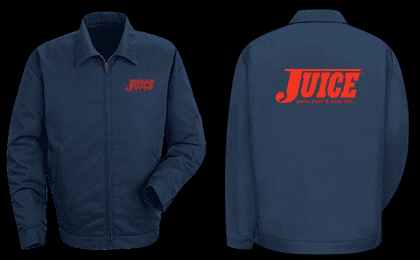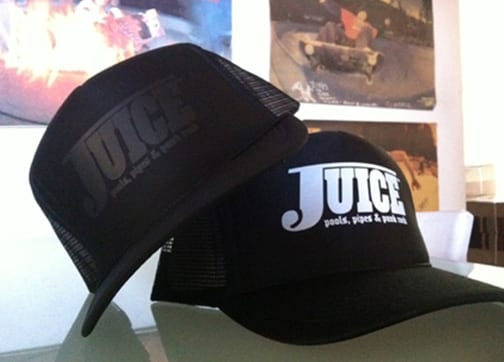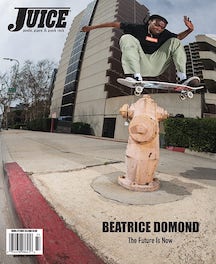INTERVIEW BY STEVE OLSON
INTRODUCTION BY STEVE OLSON
PHOTOS BY DAVE HUPP
Watch out for what you wish for. It will come true. When you’re into something, go for what you know. As for the results of ‘Red’, the proof is in the results, and the commitment, till death. Live the life of what you make for yourself. Do what it is that needs to be done. The time has come for all to know. Just ask ‘Red’. He is what he is. So can you be, because you can. Just take the example Mark ‘Red’ Scott. I think the world needs more of this. Red that is. Trust in it, this I know. Red is what the world needs now, along with a lil love…baby.
“I’m most proud of my volunteer projects, because when you volunteer your time, it’s worth more to you than getting paid because you did it for free and you feel more of a part of it.”
Hey, Mark.
Hi, Steve. How are you?
I’m good, man. How are you?
I’m real good.
Okay, so I’m going to ask you questions and then I might come up with a random question. It’s no big deal.
Ask me anything.
Okay, good. That’s the best thing I’ve heard yet. What is your real name?
Mark Scott.
Where does the nickname ‘Red’ come from?
When I was a kid, I started talking with a Southern accent for some reason, just to be silly, so these guys were calling me ‘Mark the Redneck from Tigard’, then it morphed into ‘Red’ for short, even though I lived pretty much in suburbia. They still thought I was a redneck for living out there. It was
more country a long time ago.
Did you grow up in Oregon?
Yeah, I grew up in Tigard. It’s a suburb of Portland.
When did you start skating?
I started skating when I was really young. My brother was nine years older than me and he had this ’70s style banana board. I took his board and rode it all the time. I was always into it, but it wasn’t until I was 11, when they started coming out with the bigger boards, that I really got into it. I was at the roller skating rink and saw these gigantic boards that were like a foot wide. I was like, ‘Holy shit! I need to get one of those!’ But I didn’t have enough bread to get one. I probably should have saved up enough money to get one, but I never did because it was like $100 and that was huge back then. I remember seeing that first Duane Peters board and it was like a foot wide, wasn’t it?
Yeah, it was maybe 11 inches wide.
They had that board in a glass case at the roller skating rink. I was like, ‘I want that.’ Later on, when I was 13, I got a crap board from Toys R Us. I just skated a lot from then on. I never really stopped, but for a broken bone or two.
What kind of stuff were you riding up there?
When I was a kid, my first sickest session ever was in a carport. We had a little concrete slab underneath the cover in the carport area. I wasn’t much older than my son is now, so I was eight or ten. I took that banana board and tied a rope to the front truck, sat on it and made my sister hold the rope and drag me around in circles. She was three years older than me, so she was a bigger person than me. I was just a little dude. She would whip me around in a circle so fast that by the time I got going to mach speed, she could just stand in the middle and I’d be flying around her, tilting the trucks into the turn as much as possible. I would yell, ‘Faster! Faster!’ My dog, Misty, would be chasing me and trying to bite me if we didn’t go fast enough. Then she’d get me going so fast that my wheels slid out and I’d hit this 4×4 post or slam into the wall. It was the sickest thing ever.
[Laughs.] When did you start riding transitions, banks and pools?
When I was 13 or 14, my friend had a quarter pipe up the street that his dad built. I went and rode that, but nobody really knew how to skate, and neither did I. I saw those other dudes drop in, so I went up there and dropped in. Those dudes were like, ‘Whoa. You just dropped in.’ I was like, ‘Yeah. Fuck it.’
Then you started building your own ramps?
Well, my dad always had wood around the house because he was in construction, so I built my own skatepark at my folks’ house. It was just ghetto ramps. When I was 14, I built a half-pipe, but I never used a stringer, so the trannies were all kinked. I just went with it. A lot of my friends couldn’t ride it because of the kinks, but I was used to it. I was always looking for tranny to skate but, realistically, I was doing whatever my friends were doing, which was just cruising around the streets. I always preferred pools and tranny, but I did it all.
Did your older brother skate for real or did he just have the board around?
He had that banana board and I think he made a couple of boards, but I don’t know if he was that into it. I’ve never seen him reading skateboard magazines or anything. He was pretty good at doing some 360s though.
That was rad back then.
Yeah. He could do 360s and he actually tried to skate my ramp, but we had such a generation gap with him being nine years older than me. By then he was getting into chicks and cars and stuff. He did take me skateboarding and I’ll never forget that. He’d tow me around with a rope on his ten-speed bike. He’d take me up to these paved hills and try to make me tow his big ass too, but I was just a little kid trying to tow this heavy dude and going nowhere.
[Laughs.] We used to tow on mini bikes through our urban neighborhood and that was probably the most fun that I ever had on my skateboard.
Yeah, as I got older, I’d always be looking for vert ramps. There were some vert ramps around, but you’d have to drive a couple of hours. Then you had to find a vehicle. My friends always gave me shit because I was always promoting the idea of getting a job. I’ve been working since I was 10 years old. I’ve always been into working. If you want something that costs money, you go to work. You get the money. It’s a no-brainer. You just do it. The day I turned 15, I got my permit to drive. The day I turned 16, I had my license and a car and I was out the door. It was freedom at last. I could drive anywhere I wanted to skate. Those were happy times. It just opened the door. My parents were cool as long as I checked in and let them know where I was going, so I hit the road. I’d go skate wherever I could, whenever I could. It was great.
Was there a lot to skate up in Oregon at the time?
It was just street and some vert ramps. There was a vert ramp called the Cage Ramp in Eugene. When that went down, there was a vert ramp in Corvalis. When I got even older, like 20, we started Burnside. That was a major project that took forever and is still going on. Burnside was like the solution to the problem. It was a shit hole under a bridge. It was semi dry or dry, almost all of the time, because it was under the bridge. That place has really helped me out to be able to skate year round for sure.
What was the first concrete skatepark you rode?
Well, I’d drive down to the Nude Bowl and then go skate Derby. I went to Upland when it was getting torn down. I should have hopped the fence, but I was paranoid. Most of it was already unskateable anyway. I skated the Buena Vista pool and had some cool missions. I went on a couple of missions to the Turf as well. That was great. I drove all the way there from Oregon.
You drove from Oregon to ride the Turf?
Yeah, Munk and I went non-stop from Seattle to the Turf. It took something crazy like 30 or 40 hours. We pulled it off nonstop. We took turns sleeping and driving.
Wow. The reason I asked is because I want to know how you got into concrete.
I got into concrete because of Burnside. We didn’t know what the hell we were doing, but we had the material to use. It started out kind of hokey, but we learned how to use concrete down there.
How did Burnside come about?
Well, it was just an idea. These guys put a little bank down there and it was on. I don’t know what I was doing that night, but I didn’t even help put the first bank there. It was two feet by three feet tall. I was like, ‘What? You guys did that already?’ I was pretty pissed off. I was like, ‘Well, I’m building my bank right next to your bank.’ In two days, I built my bank with more concrete and more tranny in it. It was just on from there. We’d all help out building all the banks, whoever was there at the time. It started with the bank to the existing wall, which was flat. We used to ride there even before the banks. It was pretty steep, but you could do wall rides on it. That’s the big wall that’s still there today.
Where did the first concrete come from for Burnside?
It was from a lumberyard. We got the broken bag discount. We’d take bags that were messed up for $1 or whatever.
Why build under the bridge at Burnside?
Well, it was a lot more rundown back then, and there were very few buildings around. It was just a shit hole and there was garbage everywhere and it was a pretty hard lurk zone. It was no man’s land back then. There was a condemned warehouse that was like a heroin junkie hangout. A lot of people would squat in there, until they finally tore that down. So anyway, one of the few neighbors there saw us building it up. I went and talked to her a few times and she kind of became the mother of Burnside. She was stoked on what we were doing. The way she described it is, ‘Before those skateboarders were there, it was nothing but pimps, prostitutes and pushers!’
[Laughs.] Right.
She also just happened to be a big community organizer, so she was the perfect ally to have. If problems came up that we didn’t know how to deal with, she helped us out. Even the cops helped out. I know a lot of skateboarders don’t like cops, but these cops went down there in the beginning and helped us keep the place. They thought it was cool that we were driving out the pimps, prostitutes and pushers.
[Laughs.] What about the pimps, prostitutes and pushers? They were probably pissed.
I don’t remember seeing any pimps, but maybe I wasn’t really looking. There were plenty of areas for them to go. We were more pissed about the bums that were shitting in our area. It was like, ‘You guys gotta go.’ On the other hand, one of the guys that helped with a major part of the volunteer work down there was a homeless guy. I became good friends with him. His name is Germ. He’s in jail right now, but hopefully he’ll get out and figure it out.
How did it go from there? Did the city freak out?
Well, a couple of years went by and the city finally realized what we were doing, so we went to the city council and said, ‘Here we are. This is what we’re doing. What do you want?’ They were like, ‘This is great.’ We had a huge showing at the City Council. There were 40 skaters that showed up at that meeting. It was a whole room full. Then the city council said, ‘Okay. You guys can stay down there as long as you keep cleaning up and stuff.’ We said, ‘Okay. Sure.’
So they were cool about it. Did they have any idea that skateboarding would get as big as it is now?
Well, we moved forward pretty quickly in those first couple of years. It was starting to really grow into something. The city probably had no idea what it would turn into. It’s a funny story. I was down there a lot in the beginning, and then we started getting some banks out in the street where you could go back and forth. We started having a little park in there. I told Taylor one night, ‘Some day this whole area is going to be covered with concrete and it’s going to be badass.’ He said, ‘Yeah, right.’ I said, ‘No, dude. It will.’ I was not joking, but I think back now and it must be my karma for saying that.
[Laughs.]
It seemed like a major operation back then, but we did it. What really helped was that we got a lot of leftover concrete from the concrete plant. Basically, they got sick of me bugging them all the time. To get me off their back, the dispatcher gave me some mud. It was old, hot concrete that you had five minutes to shape and form or you’re screwed. Not only was it trowelled and aired, but we were also dealing with some bogus material that was very hot.
Had anyone really worked with concrete that started helping build Burnside?
We had no idea what to do, but we figured it out. Then I started doing it for a living in 1996. That helped a lot having hands on everyday. We pretty much taught ourselves. If you play with something long enough you’re going to figure it out. It’s a good way to learn. You figure it out the hard way
and keep on trying. People would come in and give us pointers. That helped.
Did you have trowels when you first started doing the concrete?
[Laughs.] We had a busted trowel and a broken pointed shovel.
[Laughs.] Who was designing it?
It was whoever was around. We’d all get on the same page and just do it. Sometimes people would come up with ideas and if they weren’t around to expedite the work, then we’d build whatever we wanted.
Did you ever think that you’d be building all of these crazy skateparks around the world?
No. In the back of my head, I was hoping to, but I never knew that skateparks would become as popular as they are now. I tend to think that Burnside probably helped the whole skatepark revolution because it came about with pretty good timing. There was some stuff to skate, but there wasn’t a
whole hell of a lot to skate in the ’90s.
When did Burnside happen?
It started in October 1990.
So you guys are responsible for the skatepark revolution, the second coming?
We probably helped a bit.
I think so. I have to say thank you because then it was fucking excellent again. How do you go into designing your parks now?
There are so many different ways to approach designing a skatepark nowadays. The best scenario is when they want us to lead the team and do the design, but the reality is that 80% of the parks have some type of committee. Usually, the committee wants to have some input, so we have design meetings with them and come up with concepts and make sure they like it. Other times, not so commonly, they’ll say, ‘You guys design it.’ Those are the best parks that we’ve done. We come up with crazy shit that’s pretty epic. They give us that freedom. We did that in Bologna, Italy and Hailey, ID.
Hailey, Idaho said, ‘Just build us a skatepark.’
Yeah. Sometimes you can get a really good park, but it’s really a challenge when the skate committee is eight year olds, ten year olds and 13 year olds that don’t really know what they want. You’re trying to design a park for them and they want shit you can find in any semi-large city that’s there naturally. Then they expect you to use everything they put in there. That makes it a real challenge to do the best job you can. You’re held back by design restraints from the committee. We always do our best to build what they want and still deliver a park that flows.
FOR THE REST OF THE STORY, ORDER ISSUE #65 BY CLICKING HERE…
SHARE THIS POST:
- Click to email a link to a friend (Opens in new window)
- Click to share on Tumblr (Opens in new window)
- Click to share on LinkedIn (Opens in new window)
- Click to share on Pinterest (Opens in new window)
- Click to share on Twitter (Opens in new window)
- Click to share on Facebook (Opens in new window)
- Click to share on Reddit (Opens in new window)
- Click to print (Opens in new window)












One Response